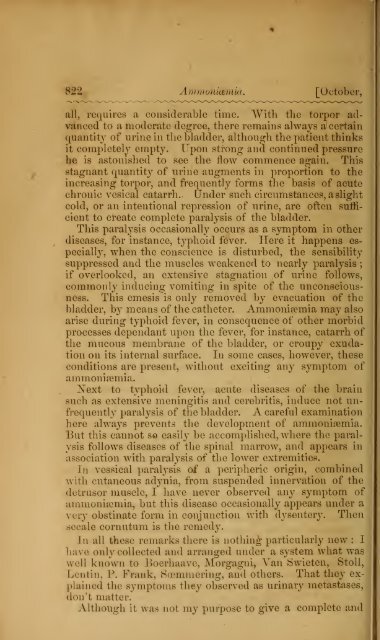Ammonimmia. 821a of the kidneys, lead either to ammon"nemia or nramia.A painful anuria, sometimes relieved by copious dischargesof bloody urine, pain and swelling in one or bothsides of the abdomen indicate the primitive cause. If thereis a concretion, the ureter becomes dilated above and aroundit, the walls are pushed outward, and the room thus madeallows the urine to pass until the stone, pressed downwardsis again wedged in. Even large concretions may, in thisway, reach the bladder, and as long as the other kidney isnot disturbed in its functions, there is not much danger..V continued stagnation of the urine in the pelvis of thekidney may, however, result in decomposition and resorption; that is, ammoniaemia. Of course, death may ensuewithout that—for instance, as a consequence of anuria anduremia in 6bl iterationof the ureter.Tuberculosis of the kidneys is also one of the excitingcauses of ammoniremia. How far abscesses of the same,ns may have the same effect, cannot be at present ascertained,besause they were complicated with diseases ofthe bladder, wherever observed with the disease in question.The kidneys may be destroyed by extensive ulceration,ending in death, without one symptom of ammoniaemia.Cancer of the kidneys is also not likely to produceit.Another form of ammonimmia, distinguished by a veryrapid course, arises from the decomposed urine penetratinginto normal tissues. This may ha<strong>pp</strong>en, for instance, intothe cellular tissue of the peritoneum, by ulcerative ruptureoi* the urethra, or into the tissue of the abdominal wallsafter puncture of the bladder, when the urine was in a statelecomposition in consequence of previous dise;There are violent pains, frequent chills, vomiting and frequentdiarrhea, ending in sopor and death.The senile vesical torpor developes itself, without anydemonstrable morbid affection of the bladder or urethra, inpersona about, or beyond the age of fifty. The circumstancesinfluencing its a<strong>pp</strong>earance and development, are notalways easily determined. It is only certain that this torpor.iher from insuiheient innervation or from retrometamorphoHfland fatty degeneration of the fibreslie detrusor muscle. Patients afHicted with this troublecannot pas< their uri ept with strong abdominal pressure,and then only in a short and interrupted stream. Acomplete evacuation of the bladder, if it can be effected at
822 Ammonicemia, [<strong>October</strong>,all, requires a considerable time. With the torpor advancedto a moderate degree, there remains always a certainquantity of urine in the bladder, although the patient thinksit completely empty. Upon strong and continued pressurehe is astonished to see the flow commence again. Thisstagnant quantity of urine augments in proportion to theincreasing torpor, and frequently forms the basis of acutechronic vesical catarrh. Cinder such circumstances, a slightcold, or an intentional repression of urine, are often sufficientto create complete paralysis of the bladder.This paralysis occasionally occurs as a symptom in otherdiseases, for instance, typhoid fever. Here it ha<strong>pp</strong>ens especially,when the conscience is disturbed, the sensibilitysu<strong>pp</strong>ressed and the muscles weakened to nearly paralysis ;if overlooked, an extensive stagnation of urine follows,commonly inducing vomiting in spite of the unconsciousness.This emesis is only removed by evacuation of thebladder, by means of the catheter. Amnioniremia may alsoarise during typhoid fever, in consequence of other morbidprocesses dependant upon the fever, for instance, catarrh ofthe mucous membrane of the bladder, or croupy exudationon its internal surface. In some cases, however, theseconditions are present, without exciting any symptom ofammoniaemia.Next to typhoid fever, acute diseases of the brainsuch as extensive meningitis and cerebri tis, induce not unfrequentlyparalysis of the bladder. A careful examinationhere always prevents the development of ammonioemia.But this cannot se easily be accomplished, where the paralysisfollows diseases of the spinal marrow, and a<strong>pp</strong>ears inassociation with paralysis of the lower extremities.In vessical paralysis of a peripheric origin, combinedwith cntaneous adynia, from suspended innervation of thedetrusor muscle, I have never observed any symptom ofammoniaemia, but this disease occasionally a<strong>pp</strong>ears under avery obstinate form in conjunction with dysentery. Thensecale oornutum is the remedy.In all these remarks there is nothing particularly new : Ihave only collected and arranged under a system what waswell known to Boerhaave, Morgagni, Van Swieten, Stoll,Lentin, P. Frank, Soemmering, and others. That they explainedthe symptoms they observed as urinary metastases,don't matter.Although it was not my purpose to give a complete and
- Page 1 and 2:
SOUTHERNfttcMcai avto Surgical Imtt
- Page 3 and 4:
practical754 i;i'Ji J'oXes, on the
- Page 5 and 6:
756 Joseph Jones, on the Indigenous
- Page 7 and 8:
;7 58 Joseph J ones, on the Indigen
- Page 9 and 10:
760 Joseph Jones, on the Indigenous
- Page 11 and 12:
762 3EPflJoKfis, bn the Indigenous
- Page 13 and 14:
764 Joseph Jones, on the Indigenous
- Page 15 and 16:
7'!
- Page 17 and 18:
—'.emeticssbfhJohi[Octobameliorat
- Page 19 and 20: 770 Joseph Jones, on the Indigenous
- Page 21 and 22: 77-? Joseph Jones, on the Indigenou
- Page 23 and 24: 7 74 Joseph Jones, on the Indigenou
- Page 25 and 26: 776 Joseph Jones, on 1 the Indigeno
- Page 27 and 28: 778 Joseph Jones, on the Indigenous
- Page 29 and 30: 780 Joseph Jokes, on (he Indigenous
- Page 31 and 32: 782 Joseph Jones, on the Indigenous
- Page 33 and 34: :784 Joseph Jones, on the Indigenou
- Page 35 and 36: —786 Joseph Jones, on the Indigen
- Page 37 and 38: 788 Dvphtlima. [October,to confound
- Page 39 and 40: 700 Diphtheria. [October,*almost in
- Page 41 and 42: 792 Diphtheria. [October,in water a
- Page 43 and 44: 704 Diphtheria: [October,find favor
- Page 45 and 46: 796 Diphtheria. [October,tongue. \)
- Page 47 and 48: 798 Uterine Inflammation. October,b
- Page 49 and 50: 800 Uterine Inflammation. [October,
- Page 51 and 52: 802 Uterine Inflammation. [October,
- Page 53 and 54: elhrai804 me Inflammation. [October
- Page 55 and 56: ;806 Phlegmasia Dolens. [October,Th
- Page 57 and 58: SOS Termination ofNerves. [October,
- Page 59 and 60: cl Termination of Nerv October,] to
- Page 61 and 62: —812 Development of Bloodvessels.
- Page 63 and 64: —814 ( orpuscles of the Spleen. [
- Page 65 and 66: —Mi; Ammomcemh. [October,tubes in
- Page 67 and 68: 818 Ammoniamia. [October,v^^%/\yof
- Page 69: 820 Arnmoniccraia. [October,combine
- Page 73 and 74: 824 Galcano Cautery in Cataract. [O
- Page 75 and 76: —826 Editorial. [October,MEDICAL
- Page 77 and 78: ———828 Miscellaneous. [Octobe
- Page 79 and 80: ———830 Miscellaneous. [Octobe
- Page 81: —832 Miscellaneous.was employed f








